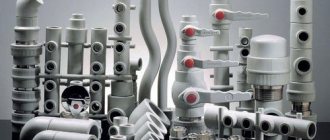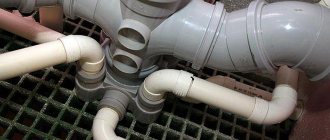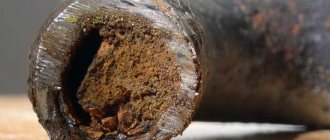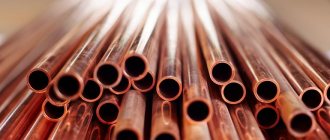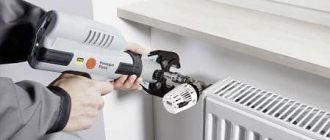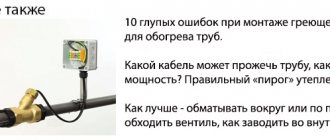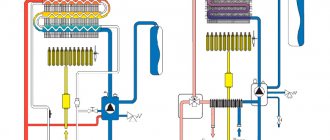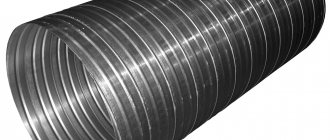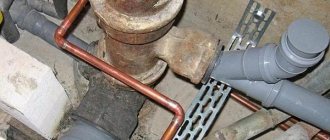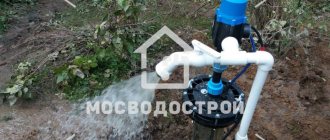Question :
According to SP 30. 13330. 2012 clause 7. 1. 2 cold and hot water pipeline systems must be made of pipes and connecting parts, the service life of which at a water temperature of 20 ° C and standard pressure is at least 50 years, and at a temperature of 75 °C and standard pressure - at least 25 years, while the hydraulic resistance must remain unchanged throughout the entire service life.
How is the service life of a pipeline made of galvanized steel water and gas pipes determined according to GOST 3262-75 for the installation of internal drinking water supply networks and hot water supply in boiler houses?
The documents for the pipe according to GOST 3262-75 do not provide a service life.
Answer :
Article 470 “Guarantee of the quality of goods” of the Civil Code of the Russian Federation states that the goods that the seller is obliged to transfer to the buyer must meet the requirements provided for in Article 469 of this Code, and within a reasonable period must be suitable for the purposes for which goods of this kind are usually used .
When using galvanized steel pipes in accordance with GOST 3262-75, their service life will depend on the operating conditions.
To roughly determine the minimum effective service life of these pipes, you can use the recommendations of VSN 58-88(r): “Regulations on the organization and implementation of reconstruction, repair and maintenance of buildings, municipal and socio-cultural facilities”, Appendix 3, recommended: “Minimum duration of effective operation of building elements and facilities.
Duration of operation before major repairs (replacement)": Cold water pipelines from galvanized pipes - 30 years (residential buildings), 25 years (municipal facilities).
Hot water supply: Hot water pipeline from galvanized gas pipes (gas black pipes) for heat supply schemes: closed - 20 (10) years (residential buildings), 15 (8) years (municipal facilities); open - 30 (15) years (residential buildings), 25 (12) years (public utilities).
The service life of a pipeline can be calculated taking into account operating conditions, parameters of pipes, waterproofing and thermal insulation coatings. For example, such calculations are given in GOST 24723-81 “Galvanized steel sea water pipelines. Calculation of the durability of elements."
| Dear visitors! The site offers standard solutions to problems, but each case is individual and has its own nuances. |
| If you want to find out how to solve your particular problem, call toll-free ext. 504 (consultation free) |
The use of modern insulating materials significantly increases the service life of pipelines, for example:
GOST 30732-2006 “Steel pipes and fittings with thermal insulation made of polyurethane foam with a protective shell. Technical conditions": "A. 2 At the given temperature conditions, the service life of insulated pipes and fittings must be at least 30 years.”
Thus, there is no single option for calculating the service life of a pipeline made of galvanized steel pipes, but there are recommendations based on many years of experience in their use (VSN 58-88(r)), and calculations that take into account the use of specific pipes with specific insulation in specific conditions (for example : GOST 24723-81, GOST 30732-2006).
Types of structures
- Suture. They are not used in home heating systems, since bending breaks the integrity of the seam and causes it to separate. When producing this type, the seam is not processed from the inside, so leaks occur in such places and replacement will be required. The maximum that can be expected from such a pipe is 3 - 5 years.
- Seamless. More reliable products. The service life of such water pipes can last up to 20 - 30 years, subject to care and timely cleaning of lime deposits and iron oxide. New production technologies make it possible to use special coatings for highways - enamel, ceramics, zinc, which increase the service life and allow you to go without repair or replacement for a long time.
Steel structures are used not only for water, but also for gas and oil pipelines. The duration of use is regulated by GOST standards. The regulatory documentation also specifies test methods, acceptable welding methods, connection possibilities, technical capabilities of steel pipes - throughput, resistance to pressure and temperatures.
Standard service life of water supply steel pipes according to GOST
There is no state standard for the service life of steel pipe structures. The average working life of steel mains is about 20 - 25 years, subject to proper operation and professional installation. The duration of operation of water supply structures depends on the quality of steel, wall thickness, additional insulation against condensation or anti-corrosion coatings.
The characteristics of steel lines may vary depending on the composition of the pumped liquid, its temperature and pressure. The remaining service life of used pipes is determined by an expert commission. Wear calculation is calculated
the ratio of the actual service life to the standard one, the resulting value is multiplied by a factor of 300.
Galvanized water pipes
Galvanized steel pipes are a durable material for the construction of water supply systems. Their technical features are:
- resistance to rust formation inside;
- resistance to increased pressure;
- protection against the negative effects of high temperature;
- absence of harmful compounds that can get into food with water.
Non-ferrous metals do not form rust. Zinc is one such metal. They cover both the inside and outside of the water pipe.
The service life of the pipeline depends on the thickness of the applied coating, as well as on the application method. Galvanizing is allowed in several ways:
- Thermal diffusion method. In a closed container, the steel is exposed to zinc vapor at high temperatures. With this treatment, complete adhesion of steel and zinc particles occurs, which makes it possible to obtain a dense, evenly distributed coating over the entire area of the pipe.
- Hot galvanizing. The prepared pipe is immersed in molten zinc at temperatures up to 450 degrees. With this method, non-ferrous metal fills the threaded connections and lays down in an uneven layer - there are sagging and thickening. The method is uneconomical.
- By electrolysis method. The layer of non-ferrous metal is uniform, but does not have strong adhesion to the steel surface, which in the future can provoke chips and cracks in the coating. The porous structure of the zinc layer allows aggressive liquids to penetrate and damage the steel.
Depending on the purpose of galvanized steel structures, a coating method is chosen - more or less reliable.
Galvanized lines have a number of advantages over simple steel pipes during operation:
- thermal expansion deforms structures less;
- resistant to mechanical damage;
- a smooth internal surface increases the throughput of the pipeline, which reduces the risk of the pipe section becoming overgrown with foreign deposits - lime, sand, dirt;
- withstand pressure up to 1.6 MPa;
- resistance to iron oxide damage for 20 years or more.
It is not recommended to use galvanized elements when organizing wells for home water supply. Contact with the ground changes the chemical parameters of water, and corrosion may form at the joints due to damage to the zinc coating during welding.
The safest and longest lasting galvanized lines can be used to deliver cold water with a high pH - from 7.5 to 8.5. This is rare for a city water supply, since not everywhere there are installations for high-quality wastewater treatment and reducing its acidity.
Hot water increases the rate of corrosion formation by 5 times, and temperature fluctuations inside the pipe cause the destruction of the protective coating.
Connections between galvanized and copper pipes also reduce the quality of the coating, since copper ions act aggressively and reduce the life of the pipeline.
According to regulatory data, galvanized steel structures:
- should not have cracks or swelling;
- may have traces of stripping if the protective coating layer is not reduced to the maximum permissible values;
- the end parts should not have delamination or nicks exceeding 0.5 mm;
- The cut is made at a right angle, the bevel is no more than 2 degrees.
The sections may not have a zinc coating, as they are intended for welding. Coupling connections are covered with a full protective layer with a thickness of at least 30 microns.
What is the standard service life of water pipes?
The reality of our life is that there is no regulatory document regulating the service life of steel water pipes, although there is an instruction from 1971, which, unfortunately, is better not to refer to, because
it is outdated in every way. There is a term “average standard service life of a pipe,” defined as 20-25 years, which is used in most calculations.
And the point is not in bad technical “legislation”, but in the pipe itself, since the same pipe under different operating conditions can last for different times.
Despite the fact that plastic is everywhere replacing traditional materials, all important structures are still made of metal, including water mains.
For some reason, we have adopted a “standard” for water pipes that the degree of wear is the complete failure of the system, when repair clamps are installed on the clamps.
However, before determining the service life of steel water pipes, it is necessary to clarify that this period is calculated from the moment the pipeline is launched, and not from the manufacture of the pipe, since there are “stale pipes” on sale.
Service life of water pipes
- High level of flammability. During a fire, plastic pipes not only burn, but also release a lot of toxic substances into the environment.
- Poor structural rigidity. Polymer pipes cannot resist either transverse or longitudinal deformations.
- Susceptibility to mechanical damage. The pipe can be damaged by any sharp or heavy object.
- High-carbon, structural, unalloyed steel without corrosion protection, otherwise known as “black.”
- Copper of a high purity level with a minimum amount of impurities of antimony, lead and arsenic (less than 0.001 percent).
- High-carbon, structural steel with a zinc-based anti-corrosion coating, otherwise known as galvanized steel.
- Steel alloyed with chromium, or “stainless steel”.
Interesting: What is the difference between a specialty and a bachelor's degree?
Standard service life of steel pipes according to GOST
Galvanized steel products overgrow much more slowly. Firstly, the smoothness of the wall is much higher, and secondly, there is much less “garbage” itself - particles of rust, scale, sand. But if the taps in the plumbing system are not fully opened and there is not a sufficiently dense flow of water, scale and sand can accumulate.
- the service life of steel water pipes - riser or liner - is 15 years;
- the heating system assembled from gas steel pipes is suitable for use for 10 years;
- heated towel rails in the bathroom can “work” for 15 years;
- According to GOST, the standard service life of a gas pipeline made of steel pipes is 30 years.
Service life of metal water supply pipes: standard and actual service life of the water supply system
In the author’s memory, the minimum trouble-free service life of a steel cold water supply system in a new building was only 10 years.
The house was built and delivered shortly before the collapse of the Union, in conditions of austerity on building materials and the actual inoperability of Soviet norms and standards.
Lightweight VGP pipes, purchased for reasons of economy, quickly and en masse began to leak at welded joints and threads.
Please note: a steel line overgrown with deposits can often be cleaned with a steel cable or string. Even more effective destruction of deposits is ensured by chemical flushing of the water supply system: an alkaline or acidic environment dissolves lime and iron oxides.
Standard service life of water supply pipelines
The main document establishing the standard service life of utilities in a residential building is VSN (departmental building codes) number 58-88, adopted in 1988.
They regulate the timing of maintenance, reconstruction and repair of buildings.
The document regulates the procedure for repair and reconstruction of buildings. Appendix No. 3 to the document provides the following figures: What factors limit the service life of VGP pipes without anti-corrosion coating: Service life of steel structures
Not a single facility can be built without pipelines; these durable and strong profiles made from a wide variety of materials are used in almost all sections of the construction industry.
A variety of materials are used to make pipes, and their service life depends not only on the properties of these materials, but also on the chemical activity of the medium transported through the pipes and in contact with the inner surface.
The service life of pipes is also directly dependent on the temperature indicators of both the media passing inside and the conditions in which the structures operate.
PVC pipes service life, service life of plastic pipes
- Safety, non-toxic and non-flammable raw materials.
- Practicality in use and when laying highways.
- Light weight.
- Possibility of long-term operation without clearing blockages.
- Absolute neutrality to corrosion and aggressive substances.
- Resistance to various living microorganisms.
- High durability.
Interesting: Sample Consent of a Spouse for the Purchase of an Apartment
The service life of PVC sewer pipes, according to manufacturers, is more than 30 years. However, when purchasing such polyvinyl chloride products, it is necessary to take into account the conditions under which the pipeline model will be operated and what potential factors affecting it exist.
For example, it is necessary to take into account the exposure of collectors to external environmental influences (weather conditions, ultraviolet light, etc.) and indoor humidity levels. It also doesn’t hurt to assess the likelihood of mechanical impact from outside and the risk of microorganisms multiplying inside the system.
What is the service life of steel pipes for water supply and heating - material characteristics
This pipe product is characterized by good thermal conductivity, and the insignificant expansion coefficient due to temperature changes makes it possible to lay water pipes in the wall. Steel pipes, in addition, are excellent for arranging radiant types of water heating.
The service life of heating pipes made from steel is more than 20 years. They are laid both underground and in the basements of multi-story buildings, where very hot coolant moves along them with an internal pressure exceeding 6 atmospheres.
Standard service life of external steel water supply pipes
In this article we will look at several types and characteristics of pipes for home plumbing. Modern pipe manufacturers use a range of structural materials in the manufacture of their products. However, currently, only plastic or metal pipes are used in water supply systems.
The documents for the pipe according to GOST 3262-75 do not provide a service life. When using galvanized steel pipes in accordance with GOST 3262-75, their service life will depend on the operating conditions. Duration of operation before major repairs (replacement)": Cold water pipelines from galvanized pipes - 30 years (residential buildings), 25 years (municipal facilities).
Standard service life of external water pipes
Their throughput with an equal internal cross-section is lower than that of copper or polymer products. This is explained by the fact that the surface of steel pipes is rough on the inside, which prevents the free movement of liquids due to the formation of turbulence.
If we accept losses in the amount of 30% of the volume of water supplied to the network (25 billion m3), and the cost of 1 m3 of water is 30 rubles, then the cost of annually lost water will be 225 billion rubles.
District heating pipelines These pipelines supply hot water for heating and hot water supply systems.
Of approximately a third of a million km of heating networks (in single-pipe measurement), approximately a sixth are in need of replacement and repair.
Interesting: Purchase and sale agreement without transfer acceptance certificate
Service life of steel water supply pipes according to GOST
- practically not subject to corrosive destruction;
- has high resistance to chemically aggressive substances;
- from an environmental point of view it is absolutely safe;
- has the highest mechanical strength and heat resistance;
- the coefficient of thermal expansion of steel is 1.5 times lower than that of copper, and 6 times lower than that of plastics, which allows such pipes to be laid directly in the floors.
- corrosion and the tendency to accumulate biological deposits, resulting in a decrease in the throughput of the system;
- the need for systematic preventive maintenance (painting, cleaning the internal surface);
- when laying external networks, the use of special equipment is required;
- installation requires significant time and labor costs;
- relatively short service life of steel water pipes (25–30 years).
How long can steel pipes last in an apartment building?
The massive use of steel water pipes in Soviet times and in modern Russia is explained by their availability, manufacturability and the quite acceptable standard service life of pipelines made from them, providing water supply and sewerage drainage in apartments of multi-storey buildings. Rolled metal can withstand loads resulting from pressure surges.
Among the disadvantages of metal pipelines, it is worth noting the significant costs of installation work. To arrange communications, gas welding equipment is required. In addition, the significant weight of the pipes imposes additional difficulties on the process of transporting and lifting them to the work site in a high-rise building.
The service life of pipes is directly dependent on the properties of the materials used.
Such network systems behave well under water, in the ground, and in workshops; they are even used for systems operating under pressure. Plastic is interesting because of its speed of installation, low weight, and good strength and toughness. A win-win option is to use these profiles for indoor or outdoor sewerage.
Such pipes are very promising because they do not require any maintenance, they are chemically neutral, salt does not accumulate on the walls, condensation does not form, heat loss is minimal, and this allows you to do without thermal insulation. All these properties, combined with service life, make polypropylene systems the No. 1 material .
26 Apr 2021 glavurist 781
Source: https://mainurist.ru/nedvizhimost/kakoj-normativnyj-srok-ekspluatatsii-vodoprovodnyh-trub
Ferrous metals for plumbing
Compared to materials that have a variety of protective coatings, water supply structures made of ferrous metals are a budget-friendly and not the most reliable option for arranging a water supply system.
Carbon steel lines have the following disadvantages during operation:
- They are susceptible to condensation, so additional insulation of the outer layer is required. Excess steam promotes corrosion.
- Reduction in internal diameter due to sediment in areas where the water contains salt impurities. Deposits on the internal walls reduce the performance of water pipes made from steel pipes.
- Makes installation work difficult.
- They have an unaesthetic appearance.
- The service life declared by the manufacturer does not correspond to the actual one, and the pipes have to be replaced faster. It is impossible to predict how long the structure will last.
The advantages of steel water supply are:
- low cost;
- high resistance to temperatures and deformations;
- resistance to mechanical damage.
According to GOST, pipe lines must operate for a maximum of 20 years, but much depends on the quality of installation work and the chemical composition of the transported liquid.
Is it worth choosing steel pipes for water supply?
In an apartment building, the pipeline is installed with the expectation of 30 years of operation. Steel can withstand this period quite well. Blockages caused by the accumulation of sand, lime, and corrosion can reduce the performance of the pipe.
In order for steel structures to last longer, they have to be professionally cleaned from time to time, which requires additional financial costs.
The use of metal pipes from the cheap segment in apartment and private buildings is unjustified, since replacing a pipeline is a costly process and involves turning off water for several days.
It is better to choose from materials coated with special compounds - zinc, chromium, ceramics, enamel. Such materials are more expensive to purchase and install, but they last longer and do not require frequent maintenance and cleaning. A special feature of a steel pipe with chromium additives is its stated service life of more than 100 years, but there are contraindications for chlorine, which has an aggressive effect on stainless steel, so before purchasing you need to check the amount of dissolved chlorine in the water supply.
Standard service life of water pipelines
We have the highest level of centralized heating supply (up to 80%). Due to the moistening of the materials used during operation, the heat-protective properties of thermal insulation structures are sharply reduced, which leads to heat losses that are 2-3 times higher than the standard ones. Steel pipes are characterized by low cost, but the cost of their installation is high. Some experts claim that the service life of steel pipes is the same, if not longer, than that of houses - KHRUSHCHEVK and BREZHNEVOK - the house will fall apart faster than the cold and hot water risers rust and will not stand! Nowadays, it is not uncommon for housing and communal services to replace perfectly serviceable pipes only in order to “saw off a lot of money allocated for pipe replacement into their bottomless pockets.
Since then, the metal sewer system has undergone almost no changes. In modern houses and apartments you can see sewer pipes made of the following types of metals: Sewer pipes made of polymers appeared in apartments only at the turn of the 20th and 21st centuries. The length of networks (in single-pipe measurement) in Russia is impressive - it is more than 1 million km!
At the same time, about 30% (!) of pipelines are so worn out that they need urgent replacement and repair. Let's take a closer look at the different types of pipelines (water supply, heat supply, sewerage), their condition and problems arising due to their wear and tear and poor quality. This is clearly visible in Table 1. Table 1. Construction technologies No. 4, 2004 Without pipes, it is impossible to imagine the life of not only an individual house or enterprise, but also entire districts and cities. Pipes are used to move cold and hot water, to create heating mains, sewerage systems, and for many other purposes.
True, its cost is somewhat higher, but at the same time such a pipe: is practically not subject to corrosive destruction; has high resistance to chemically aggressive substances; from an environmental point of view it is absolutely safe; has the highest mechanical strength and heat resistance; the coefficient of thermal expansion of steel is 1.5 times lower than that of copper, and 6 times lower than that of plastics, which allows such pipes to be laid directly in the floors.
Service life of water pipes
The quality of living in a country house or apartment building largely depends on what kind of water pipes were installed in it.
Let's take a closer look at the different types of pipelines (water supply, heat supply, sewerage), their condition and problems arising due to their wear and tear and poor quality.
In this article we will look at several types and characteristics of pipes for home plumbing.
Modern pipe manufacturers use a range of structural materials in the manufacture of their products. However, currently, only plastic or metal pipes are used in water supply systems. The first metal water pipes appeared in the homes of wealthy citizens 3 centuries ago.
Since then, the metal sewer system has undergone almost no changes. In modern houses and apartments you can see sewer pipes made of the following types of metals: Sewer pipes made of polymers appeared in apartments only at the turn of the 20th and 21st centuries.
Service life of metal water supply pipes: standard and actual service life of the water supply system
No, this is not the Alien's digestive system. Just the insides of an old water supply pipe. How long do metal pipes last for water supply? Today we have to rummage through the regulatory documentation to find the answer to this question and find out why the service life of pipelines is being reduced.
Actually, there are currently only four of them:
- Corrugated stainless steel.
- Black steel (water and gas pipes GOST 3262-75);
- Galvanized steel, produced to the same standard;
- Copper;
It’s interesting: just a few decades ago, cold water supply lines were massively laid with cast iron pipes.
Let's get started. First, let's remember exactly what types of metal pipes are used in cold and hot water supply systems.
Pipeline service life
Article 470 “Guarantee of the quality of goods” of the Civil Code of the Russian Federation states that the goods that the seller is obliged to transfer to the buyer must meet the requirements provided for in Article 469 of this Code, and within a reasonable period must be suitable for the purposes for which goods of this kind are usually used . According to SP 30. 13330. 2012 clause 7. 1. 2 cold and hot water pipeline systems must be made of pipes and connecting parts, the service life of which at a water temperature of 20 ° C and standard pressure is at least 50 years, and at a temperature of 75 °C and standard pressure - at least 25 years, while the hydraulic resistance must remain unchanged throughout the entire service life. The service life of a pipeline can be calculated taking into account operating conditions, parameters of pipes, waterproofing and thermal insulation coatings. For example, such calculations are given in GOST 24723-81 “Galvanized steel sea water pipelines.
Calculation of the durability of elements." To roughly determine the minimum effective service life of these pipes, you can use the recommendations of VSN 58-88(r): “Regulations on the organization and implementation of reconstruction, repair and maintenance of buildings, municipal and socio-cultural facilities”, Appendix 3, recommended: “Minimum duration of effective operation of building elements and facilities. Hot water supply: Hot water pipeline from galvanized gas pipes (gas black pipes) for heat supply schemes: closed - 20 (10) years (residential buildings), 15 (8) years (municipal facilities); open - 30 (15) years (residential buildings), 25 (12) years (public utilities).
Thus, there is no single option for calculating the service life of a pipeline made of galvanized steel pipes, but there are recommendations based on many years of experience in their use (VSN 58-88(r)), and calculations that take into account the use of specific pipes with specific insulation in specific conditions (for example : GOST 24723-81, GOST 30732-2006).
Standard service life of water supply pipelines
Where is the standard service life of water supply risers in an apartment building indicated?
The standard service life of water supply risers in an apartment building can be found in Appendix No. 2 to VSN 58-88 (r) (departmental building codes, which are entitled as follows: ““Regulations on the organization and conduct of reconstruction, repair and maintenance of buildings, public utilities and socio-cultural purposes"). In the section “Elements of residential buildings, municipal and social-cultural facilities” it is stated that cold water pipelines from gas black pipes must be changed after 15 years, and from galvanized pipes - after 30 years.
Risers belong to the common property of the residents of the house, but the user is obliged to keep them in good condition. If your neighbors have the same story, then it is better to write a collective statement (written, in duplicate) and attach photographs of rotten risers to it.
Steel pipes: nuances of operation
It is completely impossible to prevent it.
It can only be slowed down if zinc coating is used in the production of pipes (inside and outside). When purchasing metal communications, pay attention to the method of their manufacture (this affects their service life). They can be either electric welded and used for water supply systems, heating systems and gas pipelines, or seamless. The fact is that the throughput of pipes with an equal internal diameter is lower than, for example, that of copper or polymer.
The service life of pipes is directly dependent on the properties of the materials used.
both domestic and industrial;
like chimneys and ventilation pipes. One of the main regulatory documents.
regulating the use are Departmental Construction Standards VSN 58-88 (r), approved. by order of the State Committee for Architecture of the Russian Federation under the State Construction Committee of the USSR dated November 23, 1988 N 312. And also UDC 621.64:539.4+62-192
“Assessment of the service life of pipelines taking into account corrosion damage” 2010
It is very difficult to name those areas in which steel pipes are not used.
They are used in oil pipelines, heating mains, main water pipelines, heating systems and many others.
Many people are interested in how long a steel pipe can last. Their service life depends greatly on operating conditions.
- suture.
This is the cheapest type of steel pipe. Choosing this type of heating is doomed to failure in advance, since its service life is only a few years and they will not live up to thirty years. This is because when installing a heating system, it is very difficult to bend such a pipe and the seam simply bursts at the bend.
Also, the inside of the seam cannot be properly processed; a leak may appear and the pipe will need to be replaced. Therefore, it is not suitable for heating systems;
- seamless.
Such pipes are much more reliable.
For individual heating, such pipes with a diameter of 25 mm are recommended; when tested, they can withstand loads of up to 20 atmospheres. Therefore, for at least twenty years, such pipes will last without problems.
Remember that previously only steel pipes were installed for the heating system. And often, when installing autonomous heating and replacing steel pipes with plastic ones, it turned out that they could serve for a long time, despite the fact that they were installed twenty years ago.
Standard service life of water supply pipelines
3.3.4 Detachable connections are provided in places where fittings are installed on the pipeline and connected to equipment and for the possibility of dismantling pipeline elements during operation.
These connections must be located in areas accessible for inspection and repair. 3.3.5 The connection of pipes made of dissimilar non-adhesive and non-weldable modified and composite polymer materials is carried out using mechanical connections, the design and application technology of which are established according to the data of their manufacturers and suppliers for a specific polymer material.
Service life of metal water supply pipes: standard and actual service life of the water supply system
Please note: a steel line overgrown with deposits can often be cleaned with a steel cable or string.
Even more effective destruction of deposits is ensured by chemical flushing of the water supply system: an alkaline or acidic environment dissolves lime and iron oxides.
In the author’s memory, the minimum trouble-free service life of a steel cold water supply system in a new building was only 10 years.
propuskspb.ru
Standard service life of steel pipes according to GOST
Alas, this option is not particularly durable. Even with the most careful painting and care, they will rust over time. The fact is that after the construction of communications, individual fragments turn out to be inaccessible, and it turns out to be impossible to update the paint, for example.
- black steel pipes - steel of different grades is used in production, but it is not corrosion resistant. Such rolled metal products require additional protection - painting, for example;
- galvanized steel pipes - products are coated with a layer of zinc. The latter forms a galvanic couple with iron and is destroyed by an electrochemical reaction, protecting the steel from corrosion. Obviously, the service life according to SNiP and GOST for such a model is much longer;
- stainless steel – alloys with the addition of nickel and chromium. Depending on the size of the alloying additive, steel can be resistant to corrosion under normal conditions, is characterized by increased resistance, which allows use in sea water, for example, and also does not oxidize under the influence of not only moisture, but also high temperature. The product does not need protection, however, its cost is noticeably higher;
- copper - rare, but used in domestic conditions. They are distinguished not only by their resistance to corrosion, but also by their disinfecting properties.
This material is much more resistant to corrosion, which significantly extends the standard time. The most significant destructive factor here is only the welded connection, if for some unknown reason the installation is carried out by welding. The photo shows water and gas steel pipes.
One of the important characteristics of the product is, among other things, the period of operation. Any material wears out over time, but this time can be very different and depends on the load, on additional factors and, of course, on the quality of the product itself. The standard service life of steel water pipes largely determines their purpose.
- the service life of steel water pipes - riser or liner - is 15 years;
- the heating system assembled from gas steel pipes is suitable for use for 10 years;
- bathroom heated towel rails can “last 15 years;
- According to GOST, the standard service life of a gas pipeline made of steel pipes is 30 years.
In fact, destructive factors of various kinds significantly reduce the operating time. For example, a pipeline with cold water wears out much faster than with hot water, since it rusts faster: condensation appears in the warm season. And the pipeline overgrows faster, since hot water contains special additives that prevent this.
Service life of a water pipeline made of steel pipes in the ground
Warning: mysqli_real_connect(): (HY000/1045): Access denied for user 'tphilat_0_moik2'@'localhost' (using password: YES) in /home/t/tphilat/moikolodets.ru/public_html/wp-includes/wp-db .php on line 1531 Deprecated: mysql_connect(): The mysql extension is deprecated and will be removed in the future: use mysqli or PDO instead in /home/t/tphilat/moikolodets.ru/public_html/wp-includes/wp-db .php on line 1562 Warning: mysql_connect(): Access denied for user 'tphilat_0_moik2'@'localhost' (using password: YES) in /home/t/tphilat/moikolodets.ru/public_html/wp-includes/wp-db. php on line 1562 This means that either the username and password in the wp-config.php file are incorrect, or we were unable to contact the database server at localhost. The server may be unavailable.
Error establishing a connection to the database
It was at this time that an industrial method for the polymerization of organic substances was created, with the help of which the following types of structural polymers were created:
- Polyethylene is the purest type of plastic, suitable for the construction of drinking water pipelines.
- Polypropylene is a plastic with high heat resistance and high ring rigidity.
- Polyvinyl chloride is a material with excellent structural rigidity and an excellent ratio between wall thickness and product diameter, guaranteeing a high level of throughput.
In addition to the above-mentioned types of sewer pipes, water supply systems made of metal-plastic have now appeared, which are a structural material that includes layers of metal (aluminum foil) and plastic (polypropylene, polyethylene).
Service life of water pipes
Polypropylene Polypropylene is a type of plastic from which pipes of various diameters are made. Such profiles are used primarily for plumbing systems of cold and hot water supply, heating, and sewerage. The estimated durability of round hollow profiles made of polypropylene is guaranteed to be 50 years in systems with cold water and 25-30 years in systems with hot water, and the coolant can reach a temperature of +90 degrees. Such pipes are very promising because they do not require any maintenance, they are chemically neutral, salt does not accumulate on the walls, condensation does not form, heat loss is minimal, and this makes it possible to do without thermal insulation. All these properties, combined with service life, make polypropylene systems the No. 1 material.
Is it worth installing steel pipes for water supply in the house?
Info
Thus, the main advantage of steel pipelines turns out to be practically unnecessary, and the disadvantages (corrosion, and as a result through damage, loss of pumped liquid, groundwater suction, the quality of transported water deteriorates, overgrowing of the internal surface and a decrease in the internal cross-section, and as a result an increase in energy consumption pumping water, etc.) takes a lot of money. In recent years, throughout the civilized world, steel pipes have been replaced by pipes made of polymer materials. This is not at all strange, because they are not subject to corrosion, and their service life is many times greater than the “life expectancy” of steel ones.
This is clearly visible in Table 1. Table 1.
Service life of steel water pipes
True, its cost is somewhat higher, but at the same time such a pipe:
- practically not subject to corrosive destruction;
- has high resistance to chemically aggressive substances;
- from an environmental point of view it is absolutely safe;
- has the highest mechanical strength and heat resistance;
- the coefficient of thermal expansion of steel is 1.5 times lower than that of copper, and 6 times lower than that of plastics, which allows such pipes to be laid directly in the floors.
The installation of such flexible elements is extremely convenient and simple, and to connect to the fittings, the master will only need an adjustable wrench and some kind of sealant.
Pipes - veins of engineering systems
Not a single facility can be built without pipelines; these durable and strong profiles made from a wide variety of materials are used in almost all sections of the construction industry. A variety of materials are used to make pipes, and their service life depends not only on the properties of these materials, but also on the chemical activity of the medium transported through the pipes and in contact with the inner surface. The service life of pipes is also directly dependent on the temperature indicators of both the media passing inside and the conditions in which the structures operate.
Standard service life of water pipes
For modern pipe options, the international regulation EN 10224 also applies, providing:
- diameter – from 40 to 700 mm;
- wall thickness – from 2.6 to 10.3 mm.
For the thinnest products (less than 200 mm), welding technology is allowed, but in general, for the entire range of dimensional parameters, the extrusion rather than welded manufacturing method is more often used. Service life of a water supply system made of steel pipes ↑ The service life of steel pipes used in water supply systems is not determined by GOST - however, most related technical documents mention a figure of 40 years.
Steel pipes: nuances of operation
According to its standards, welded pipes for water supply systems must comply with the following linear dimensions:
- outer diameter – from 10.2 to 165 mm;
- wall thickness - from 1.8 to 5.5 mm (with separate parameters for light, regular and reinforced pipe options).
In addition, this GOST approves other technical requirements for such pipes (including permissible grades of steel used, maximum deviations in parameters, complete set of couplings, requirements for surface quality, minimum withstand hydraulic pressure, etc.).
Galvanized pipes for water supply: for or against?
This material, which is a symbiosis of plastic and metal, differs from conventional polymer pipes in a slightly different installation technology. In addition, metal-plastic pipes are produced only in certain sizes, and their diameter does not exceed 63 millimeters. Features of the range of pipes for water supply The range of metal pipes is determined by special regulatory documents. Based on the same principle, standards have been established for the production of pipes from polymers. GOST describes all geometric parameters. According to it, the minimum diameter of a steel pipe is 6 millimeters, and the maximum is 150 millimeters. For copper pipes, this figure varies from 6 to 267 millimeters, and the wall thickness can vary from 0.5 to 3 millimeters.
Polypropylene and polyethylene water pipes can be produced in 34 standard sizes.
yurist-online24.ru
Service life of metal water supply pipes: standard and actual service life of the water supply system
In the author’s memory, the minimum trouble-free service life of a steel cold water supply system in a new building was only 10 years. The house was built and delivered shortly before the collapse of the Union, in conditions of austerity on building materials and the actual inoperability of Soviet norms and standards. Lightweight VGP pipes, purchased for reasons of economy, quickly and en masse began to leak at welded joints and threads.
By the way: despite the same standard service life specified for black steel pipes in cold water and hot water systems, cold water pipes fail much faster. They rust intensively due to the condensation that falls on their surface during the hot season and quickly become overgrown with deposits due to the lack of additives that dissolve lime and rust in drinking water.
- The oldest copper water pipes have been in service for more than a century and are still in perfect condition;
- Copper does not degrade over time, is not subject to corrosion and is only afraid of significant mechanical stress: the metal is very plastic, and the pipe walls are only about a millimeter thick.
Please note: a steel line overgrown with deposits can often be cleaned with a steel cable or string. Even more effective destruction of deposits is ensured by chemical flushing of the water supply system: an alkaline or acidic environment dissolves lime and iron oxides.
- Debris accumulates in the water supply (usually cold) - sand, welding scale and rust flakes. A blockage is formed if the water supply taps are always opened only partially, and the speed of the water flow does not allow it to carry debris into the mixer and further into the sewer;
While working as a plumber, the author observed the only scenario for the appearance of fistulas on galvanized water pipes: they occurred at a welded joint. Strictly speaking, galvanized pipes cannot be welded “at all”: in the area of the seam the zinc burns out completely. You see, it evaporates already at 900 degrees, and steel melts at 1400-1500.
Service life of steel pipes
Rolled steel has a long service life, so they are widely used for the construction of all types of pipelines.
Black steel is used to manufacture products for heating systems; galvanized pipes are used for water supply.
When laying steel water pipes, it is necessary to take into account how the pipe is made, this affects the service life.
Electric welded products can be installed in all types of pipelines. They differ from copper or polymer analogues in having lower throughput.
Attention! The reduction in throughput volume in steel pipes is explained by the fact that the surface inside is not smooth, which creates obstacles to the flow of liquid.
Steel pipes are not affected by hydraulic load. Under increased load, the pipes do not wear out.
The steel pipeline underground can withstand hydraulic shocks of fifteen atmospheres and is capable of distilling liquid with almost boiling point.
Pipelines made of plastic or metal-plastic cannot bear such loads even for fifteen minutes.
How to transport and store steel pipes?
The rules for transportation and storage are specified in GOST 10692 - 80.
Steel products are stored in a room with access to fresh air, either under a canopy or on an area that has restrictions around the perimeter. Pipes cannot be stored simply on the ground. Shelves with products are located at a distance of at least one and a half meters from each other. These requirements ensure safety and do not interfere with the access of special vehicles for loading and unloading pipes.
The next metal on our list is copper.
Copper water supply: stylish and durable
How long can these metal hot water pipes last? There are no regulatory documents establishing specific service periods. Manufacturers promise a vague “50+” years.
- The oldest copper water pipes have been in service for more than a century and are still in perfect condition;
- Copper does not degrade over time, is not subject to corrosion and is only afraid of significant mechanical stress: the metal is very plastic, and the pipe walls are only about a millimeter thick.
Destructive factors
As they say in the hero city of Odessa, “there are some”:
- The service life of copper plumbing may be reduced if press fittings with rubber O-rings are used instead of soldering when installing it. Over 20-30 years, rubber loses its elasticity (primarily in hot water) and is capable of leaking;
Press fittings for copper pipes. The service life of the water supply is limited by the durability of the O-rings
- Banal erosion can lead to destruction of the walls of copper pipes. At high flow rates, sand and other suspended matter rapidly destroy soft metal;
Note: the problem is solved by installing coarse filters and limiting the water flow speed to 2 m/s.
The coarse filter at the entrance to the house is capable of purifying water from sand and suspended matter.
- Theoretically, water hammer and freezing of water in it can break a copper water supply. However, the water hammer must be truly extreme (the destructive pressure for copper pipes is 200 - 240 atmospheres), and defrosting must be repeated at least 5-6 times: the plasticity of copper allows it to withstand a slight change in diameter or length without destruction.
PIPES - veins of engineering systems
I would like to dispel the typical misconception that plastic pipes are more expensive than steel pipes. Real calculations show that even in construction they are cheaper than steel pipes. According to the Moscow Research and Design Institute of Typology and Experimental Design (MNIITEP), the use of pipes made of polymer materials can reduce the cost of the sanitary section of a residential building by 23.5%, a secondary school by 21.4%, a kindergarten by 21 , 9%. Fourth: losses of water during its transportation through leaky pipelines, amounting to tens of percent, lead to the fact that the consumer is forced to pay for water that he does not receive.
Russia annually withdraws about 80 billion m3 of water from open and underground sources for municipal, industrial and agricultural needs. If we accept losses in the amount of 30% of the volume of water supplied to the network (25 billion m 3 ), and the cost of 1 m 3 of water is 30 rubles. , then the cost of annually lost water will be 225 billion rubles. Without pipes it is impossible to imagine the life of not only an individual home or business, but also entire districts and cities.
Pipes are used to move cold and hot water, to create heating mains, sewerage systems, and for many other purposes. Not only their service life, but also the ecology of both an individual section and the country as a whole depends on the quality of pipes. Firstly: with leaky pipelines, it is impossible to ensure the supply of water from its intake to the tap without reducing the quality. Contamination of water during its transportation occurs both by corrosion products and as a result of groundwater suction through leaks.
Polluted water worsens health and affects the life expectancy of every Russian at the genetic level.
Dimensions and service life of steel water pipes
When creating an internal water supply system, it must withstand a certain load, and also be suitable for the use of special equipment. When using polypropylene, polymers and metals, it is not possible to create systems for every condition. Therefore, the specifics of environmental impact must be taken into account.
To install communication systems, it is important to be aware of the specifics of the production of structures. The service life depends on this. Unlike the use of copper or polymer pipelines, the permeability indicators of the steel type are characterized by smaller volumes. The main reason is the presence of roughness in the inner surface .
It creates vortex flows, which make the flow more complex. When planning to carry out repair work to replace a pipeline, it is necessary to familiarize yourself in detail with the characteristics of each material to ensure long-term operation. To make the right choice, it is important to find out the expected service life of steel and water pipes established by GOST, their characteristics and parameters.
- Democratic price.
- Extensive assortment. In the offered range from manufacturers you can find various diameters in the range of 6-150 mm. Therefore, they are actively used for organizing water supply and internal wiring.
- Not afraid of mechanical damage. Resistant to environmental influences.
- Resistant to exposure to hot water. In addition, a steel pipeline is not afraid of sudden temperature changes.
- Long term of active use.
Figure 2. Indicators of various types of steel
Steel water pipes
Traditionally, it was believed that water pipes, fittings, and equipment made of black steel (GOST 3262-75) provide a sufficiently long standard service life. Departmental construction standards, approved back in 1988, provided for an accident-free service life of utility network elements of 10-15 years. The disadvantages of conventional (black) steel were not taken into account, which led to a large number of emergency situations in the water supply and wastewater system.
Steel water pipes
The main advantage of steel pipes, strength, has confirmed its effectiveness exclusively in high-pressure pipelines that supply water to objects. When laid in the ground (channel method) and on the surface, water pipes with a sufficiently large internal flow area rarely fail due to the deposition of insoluble compounds. Metal corrosion is the main reason for reducing the service life of such networks.
Steel pipes used in the internal water supply system of apartment buildings, based on technical and economic feasibility and the current regulations SNIP 2.04.01-85 *, have a smaller diameter and a large number of connections. These characteristics, combined with the poor quality of water circulating in the systems, contribute to a reduction in the standard service life of water pipes.
Is it worth choosing steel water pipes and what will be their service life?
- They are susceptible to condensation, so additional insulation of the outer layer is required. Excess steam promotes corrosion.
- Reduction in internal diameter due to sediment in areas where the water contains salt impurities. Deposits on the internal walls reduce the performance of water pipes made from steel pipes.
- Makes installation work difficult.
- They have an unaesthetic appearance.
- The service life declared by the manufacturer does not correspond to the actual one, and the pipes have to be replaced faster. It is impossible to predict how long the structure will last.
There is no state standard for the service life of steel pipe structures. The average working life of steel mains is about 20 - 25 years, subject to proper operation and professional installation. The duration of operation of water supply structures depends on the quality of steel, wall thickness, additional insulation against condensation or anti-corrosion coatings.
The design and installation of steel water mains is carried out depending on the material from which they are made. The service life of a water pipe depends on the quality of the liquid for which the pipeline is used. An aggressive environment quickly damages the line from the inside if it is not protected with a special coating against chemicals.
The service life of steel water pipes depends on the type of structure.
- Suture. They are not used in home heating systems, since bending breaks the integrity of the seam and causes it to separate. When producing this type, the seam is not processed from the inside, so leaks occur in such places and replacement will be required. The maximum that can be expected from such a pipe is 3 - 5 years.
- Seamless. More reliable products. The service life of such water pipes can last up to 20 - 30 years, subject to care and timely cleaning of lime deposits and iron oxide. New production technologies make it possible to use special coatings for highways - enamel, ceramics, zinc, which increase the service life and allow you to go without repair or replacement for a long time.
What is the service life of steel water pipes?
Despite the fact that plastic is everywhere replacing traditional materials, all important structures are still made of metal, including water mains. For some reason, we have adopted a “standard” for water pipes that the degree of wear is the complete failure of the system, when repair clamps are installed on the clamps. However, before determining the service life of steel water pipes, it is necessary to clarify that this period is calculated from the moment the pipeline is launched, and not from the manufacture of the pipe, since there are “stale pipes” on sale.
Handbooks for engineering calculations.
The reality of our life is that there is no regulatory document regulating the service life of steel water pipes, although there is an instruction from 1971, which, unfortunately, is better not to refer to, because it is outdated in every way. There is a term “average standard service life of a pipe,” defined as 20-25 years, which is used in most calculations. And the point is not in bad technical “legislation”, but in the pipe itself, since the same pipe under different operating conditions can last for different times.
Longevity factors:
- Quality of rolled steel;
- Alloy metal or "soft iron";
- Seamless or seamless pipe;
- The quality of the transported water, its acidity or aggressiveness towards metal.
Household methods for determining the service life of a pipe.
These methods are not much different from professional ones, when a council of specialists cut out a piece of pipe and determine wear by its appearance and the amount of corrosion. At home, this can be done with a center punch or hand drill.
- We prepare a repair clamp of the required diameter;
- We apply a light blow to the pipe with a center punch or drill a small hole in it with a hand drill. In a normal pipe, the center punch will only leave a depression-like point, but in a “rotten” pipe, it usually punches a hole, the diameter of which is used to judge its condition.
- It’s also not so easy to drill a good pipe with a hand drill, but the 2-3mm hole from the drill is then sealed;
- We press a piece of rubber to the hole, slide the clamp along the pipe and tighten it.
If the calculated “life” of a pipe is 20-25 years, then the actual life is lower, only 10-15 years; alloy steels or “galvanization” work properly for up to 30 years, and a seamless pipe lasts longer than a welded, seam one.
lerk.ru
All about galvanized water pipes: types, standard sizes and weights, GOST table
The main disadvantage of iron bends is their rapid rusting. To protect the metal from rust, it is galvanized. The steel surface is coated with a layer of zinc, resulting in the formation of a protective film that does not allow oxygen to reach the metal and prevents the corrosion process.
Hello, dear reader! Galvanized water pipes, due to their properties, occupy a special place in the pipe products market. They are quite widespread and therefore we propose to take a closer look at their characteristics and application possibilities.
- Hot-dip galvanizing is performed by placing the workpiece in a container with zinc melted to 450°.
- Galvanic - during the electrolysis process, zinc from the electrolyte is evenly deposited on the surface of the product and forms a thin protective layer.
- Diffuse galvanizing is the treatment of the workpiece with zinc vapor at temperatures up to 450 degrees in special closed containers. Zinc particles penetrate the steel structure and form a durable coating with a thickness of up to 50 microns. As a result, the galvanized product, in addition to anti-corrosion properties, also receives electrochemical protection.
Rust should not appear in galvanized pipes. Sediments and other debris do not linger on their smooth walls. However, if the pipeline taps are not opened completely, then the flow does not have time to wash away the waste coming from the central network into the home system. Gradually, the accumulation of contaminants is cemented with lime and iron oxide and a plug appears.
One solution to this problem is to install a coarse filter. With proper installation and proper operation, galvanized channels can last over 50 years. However, in this regard, they are inferior to corrugated stainless steel pipes, analogues made of polypropylene, the service life of which is positioned to be even longer. The differences between the standards lie in some standard sizes and operating pressure indicators that standardize the documents.
Thus, products with a diameter of up to 102 mm, manufactured according to the latest two standards, must withstand 6 MPa and 3 MPa hydraulic pressure.
Service life of metal water supply pipes: Standards | Hydro Guru
No, this is not the Alien's digestive system. Just the insides of an old plumbing
How long do metal pipes last for water supply? Today we have to rummage through the regulatory documentation to find the answer to this question and find out why the service life of pipelines is being reduced. Let's get started.
Announce the entire list
First, let's remember exactly what types of metal pipes are used in cold and hot water supply systems.
Actually, there are currently only four of them:
- Black steel (water and gas pipes GOST 3262-75);
- Galvanized steel, produced to the same standard;
- Copper;
- Corrugated stainless steel.
It’s interesting: just a few decades ago, cold water supply lines were massively laid with cast iron pipes. However, now they have been almost completely replaced by pressure polyethylene ones.
A cast-iron water supply system, built more than two centuries ago, feeds the famous fountains of Peterhof
Black steel
Steel rusts. It rusts especially quickly with prolonged contact with water. That is why the service life of steel risers and connections laid down in the regulatory documents, frankly speaking, is not amazingly long.
Standard service life
The main document establishing the standard service life of utilities in a residential building is VSN (departmental building codes) number 58-88, adopted in 1988. They regulate the timing of maintenance, reconstruction and repair of buildings.
The document regulates the procedure for repair and reconstruction of buildings
Appendix No. 3 to the document provides the following figures:
| Engineering system element | Standard service life, years |
| Riser or cold water supply from gas pipes | 15 |
| A riser or hot water supply from gas pipes in a building with a closed heating system (without taking hot water from the heating system) | 10 |
| The same, in a building with an open heating system (DHW is taken from the heating circuit) | 15 |
| Heated towel rails in the DHW system | 15 |
Destructive factors
What factors limit the service life of VGP pipes without anti-corrosion coating:
| Image | Description |
| Steel water supply risers. The first fistula that caused the ceiling to become wet appeared in the ceiling | Corrosion. Rusting of the pipe is accelerated by a damaged outer layer of paint, frequent shutdowns of the water supply (in this case, the unpainted inner surface of the pipe is in contact with air with high humidity) and poor ventilation in the bathroom (read: consistently high humidity). The first fistulas appear on longitudinal welds (VGP pipes GOST 3262 - electric welded), on threads where the thickness of the pipe walls is minimal, and in ceilings where the surface of the pipes is not ventilated and (in the case of cold water risers) is continuously wetted by the condensate falling on them. |
| Lime deposits and rust have almost completely blocked the gap in the water pipe | Overgrowing of pipes with sediments (primarily lime salts) and rust. The rate of overgrowing is directly proportional to the hardness of the water in the region: where it erodes sediment on the way to the consumer, the clearance in the water supply system decreases much faster. The narrowing of the lumen leads to a drop in water pressure on plumbing fixtures connected to the water supply. |
| The diameter of steel risers is selected taking into account the reduction in pipe capacity due to deposits | Pipeline diameter. The larger the internal cross-section of the pipe, the longer it maintains acceptable throughput. |
| The thicker the wall, the longer the pipe can resist corrosion. | Wall thickness. According to GOST 3262, ordinary, reinforced and lightweight pipes are produced. It is clear that reinforced pipes will last longer until the first through fistulas appear. |
Please note: a steel line overgrown with deposits can often be cleaned with a steel cable or string. Even more effective destruction of deposits is ensured by chemical flushing of the water supply system: an alkaline or acidic environment dissolves lime and iron oxides.
Chemical flushing can transform old plumbing
In the author’s memory, the minimum trouble-free service life of a steel cold water supply system in a new building was only 10 years.
The house was built and delivered shortly before the collapse of the Union, in conditions of austerity on building materials and the actual inoperability of Soviet norms and standards.
Lightweight VGP pipes, purchased for reasons of economy, quickly and en masse began to leak at welded joints and threads.
By the way: despite the same standard service life specified for black steel pipes in cold water and hot water systems, cold water pipes fail much faster. They rust intensively due to the condensation that falls on their surface during the hot season and quickly become overgrown with deposits due to the lack of additives that dissolve lime and rust in drinking water.
The photo shows the typical condition of a cold water supply riser after 20 years of service.
The oldest engineering systems made of black steel have been in service for more than half a century.
In addition to the large thickness of the pipe walls, their longevity is facilitated by:
- Low humidity levels;
- No condensate on cold water pipes;
- Periodic painting of risers and liners;
- Low content of mineral salts in water.
Cink Steel
Thanks to its anti-corrosion coating, galvanizing should be more durable than black steel. How much?
Actual service life
The author of the article must repent to the reader: he cannot name either the minimum or maximum service life of galvanized water supply. The fact is that he has never encountered a galvanized pipe that needed replacement due to natural wear and tear.
The lines and risers, which were opened after 50-70 years of operation, were invariably in impeccable condition and were no different from new ones.
Galvanized water supply risers in the basement of an apartment building
Copper
The next metal on our list is copper.
Copper water supply: stylish and durable
How long can these metal hot water pipes last? There are no regulatory documents establishing specific service periods. Manufacturers promise a vague “50+” years.
In practice:
- The oldest copper water pipes have been in service for more than a century and are still in perfect condition;
- Copper does not degrade over time, is not subject to corrosion and is only afraid of significant mechanical stress: the metal is very plastic, and the pipe walls are only about a millimeter thick.
Corrugated stainless steel pipe
How long will corrugated stainless steel last in a water supply?
According to one of the leading manufacturers, the Lavita company - indefinitely. Lavita explicitly states that its products have an unlimited service life.
Characteristics of Lavita corrugated pipes. Please note maximum pressure and service life
However: silicone seals in press fittings will still have to be changed after 30 years. This work is not difficult: the fitting can be disassembled to replace the seal with a pair of adjustable wrenches in 30-60 seconds.
What is the actual service life of stainless steel in water supply cannot yet be said simply because of the limited time of its operation.
Conclusion
We hope that we were able to satisfy the curiosity of the reader. The video in this article will help you learn more about how long water supply pipes - metal and plastic - can last. Good luck!
Source: https://moikolodets.ru/srok-sluzhby-metallicheskih-trub-vodosnabzheniya-729
